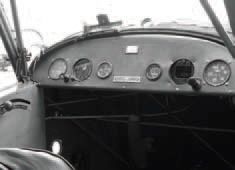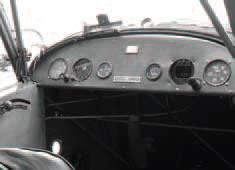
235
Some of the most popular new LSAs are distinctly old-school in their roots. There are three popular modern takes on the Piper Cub. American Champion reintroduced the venerable Champ that begat the Citabrias and Decathlons. There are even a few modern Luscombes out there from an effort to revive that line.
While these new, old-style machines will cost you north of $100,000, you can get the originals for a quarter of that. They might lack modern conveniences like, say, an electrical system or a starter motor, and they might not be in perfect condition. But then again, the $75,000 you save buys a lot of maintenance. And gas.
As with modern LSAs, we recommend you stick with the big brands. A great deal on a 1941 Interstate Cadet might sour quickly as you try to find an obscure part.
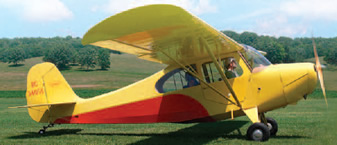
337
Piper
The Piper J-3 Cub is the iconic legacy LSA in this group, with about 19,000 produced between 1938 and 1947. Most original Cubs had the cylinders of a 65-HP Continental poking out from their cowlings, but many have been upgraded in power and technology since then. Any engines over 85 HP may need special paperwork. We’d recommend against a Cub with an old Lycoming or Franklin engine, if you can even find one.
Cubs are a joy to fly and can get airborne before seeing 45 MPH if lightly loaded. If the engine has been upgraded, they even have climb performance, so small strips are a possibility. Cruise speeds are often in the 75-MPH range—a bit more with a bigger engine, a bit less if you leave the clamshell door open for the wind-in-your-face experience.
A solo pilot sits in the back, which means forward visibility is poor until you raise the nose, at which point it becomes passable. What few instruments there are sit five feet away, but they’re not that accurate and you rarely need them. Passengers often sit up front and block your view of them anyway. Neither seat is roomy, but the front seat is less so with a 12-gallon fuel tank at that person’s knees. The fuel gauge is a wire attached to a cork that floats in the tank and sticks up ahead of the windscreen. If the wire drops too low, so does the deadstick Cub.
Some Cubs have auxiliary wing tanks that can refill the main in flight by gravity feed. Some Cubs have also been rejiggered with electrical systems (often just battery-powered), which makes life at towered airports and near Class B and C airspace simpler. We’ve even seen a few with starter motors. But all this adds weight to an already load-limited aircraft. The extra fuel is a nice perk, but a fully charged handheld and prop starting is a fine way to operate a Cub. Just be careful when you do the prop start, because simultaneously holding the Cub’s stick and operating the handheld radio is tough with only one arm.
The Cub wants coordinated flying. Coordinated stalls are mostly a transition from slow flight to slowly mushing flight. Uncoordinated stalls are good spin training—presuming you have at least fundamental spin smarts and some altitude.
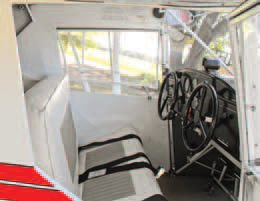
Photos courtesy Cub Air
260
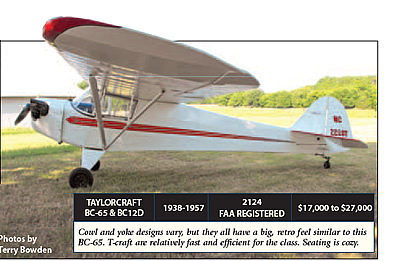
400
Steve Krog of Cub Air (cubair.net), who helps many perspective Cub buyers with perchance and training told us: “Don’t try and save money by getting a project. It’s cheaper to get a good clean one.” Painstakingly restored examples are likely to be overpriced, in our view. Bluebook gives a median price of $20,000, but we don’t see many that cheap. Expect a clean Cub that’s no showpiece to cost at least $25,000.
Variations on the theme include the L-4, built for the Army during WWII, and the Cub Special (PA-11). The PA-11 has a bit more room in the seats and is really the launching point for the modern Cub derivatives. There’s also the side-by-side Piper Vagabond, which gives a new definition to the term “cozy.” Parts support for the Piper LSAs is excellent. There are also great owner groups at www.cub-club.com and www.j3-cub.com.
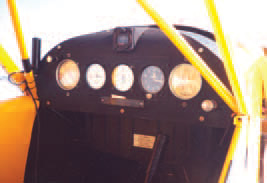
267
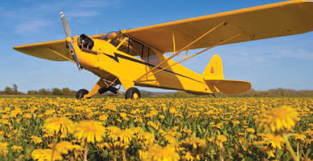
313
Aeronca
The Aeronautical Corporation of America, a.k.a. Aeronca, built about 8000 Champs over time, primarily the 7AC made between 1945 and 1948. The untrained eye might confuse one with a Cub, but the pilot experience is quite different.
Champs are wider than Cubs and can be soloed from either seat, although the front is usually the position of choice. There’s a 13-gallon fuel tank in the forward fuselage, but it’s not as intrusive as the Cub, and a Model-A fuel gauge sits atop the instrument panel. Some Champs even have heat (well, the control says heat anyway). The Champ’s oleo strut landing gear is more forgiving to hard arrivals than the Cub’s bungee cord system. Alas, the Champ lacks the clamshell door of the Cub, but it does have a large sliding window on the left side and a bit more room behind the rear seat to toss a picnic lunch.
With the same 65-HP engine, the Champ will squeeze out five to 10 MPH more than the Cub. Engine upgrades are common in Champs as well. The balance for that is a Champ lifts off at about 60 MPH, so it’s not quite as good in tight spaces as a Cub. Champs and Cubs are about equal in penalties for the uncoordinated flight and stalls, maybe slightly worse for the Champ. Champ cockpit visibility is better than the Cub in any phase of flight.
There was once a massive price delta between Cubs and Champs, with the Aeronca offering all the fun for a fraction of the cost. That delta has eroded, but still favors the Champ, especially for fully restored aircraft. Most Champs run $20,000-$25,000. Champs were also produced on and off over the years, and some later-year ones are still LSA legal and good deals.
Basically the same aircraft, but with side-by-side seating and yokes instead of sticks is the Aeronca Chief. As with the Vagabond, it’s cheaper to buy but you’d better be thin or really friendly with your copilot.
Parts support is excellent here as well. For owners groups, you have the National Aeronca Association (www.aeroncapilots.com) and the Aeronca Aviators (www.aeronca.org).
Taylorcraft
Paired with William Piper to create the original Taylor Cub design, C.G. Taylor left Piper in 1935 to form Taylorcraft. Not as we’ll known or as numerous as the Cubs and Champs, there were about 2800 of the desirable BC12D models made.
Most are equipped with the Continental 65-HP that’s becoming a theme here. Many Lycoming and Franklin T-craft have been converted to Continentals, and often to more powerful versions than the A65. Some 85-HP T-craft rolled off the line as well. There are later Model-19 T-craft, but these are not LSA legal, nor are some of the upgraded models with gross-weight bumps. However, earlier BC-65 models fly almost identically to the BC-12Ds and meet LSA specs.
Seating is side-by-side and snug. Control wheels rather than a stick drive what many consider stiff and somewhat sluggish controls. It has light wing loading and floats off the ground. It will float equally on landing if you carry too much speed. Some are modified with shorter wings—but be careful as some of these are now experimental aircraft. The original wing has excellent stability, however, even if it requires the same good rudder skills as the Cub and Champ. T-craft can reach 95 MPH in cruise and have decent climb performance. The BC12D models carry 18 gallons of gas. Pencil that out at 4.5 GPH, and that’s 21 MPG and a 380-mile full-fuel range.
Taylorcraft prices had begun an upswing after years of super-cheap status until the economic downturn. Now prices of $16,000-$18,000 are common for T-crafts. They top out at about $25,000.
Parts support is decent and your club is the Taylorcraft Owner’s Club and Foundation (www.taylorcraft.org). There is also news from the Taylorcraft 2000 company (www.taylorcraft.com), which took over the brand in 2009 and hopes to be producing parts by the time you read this. They already have inventory for 75 percent of a complete airplane and plan to offer custom-ordered complete Taylorcraft in a year or two.
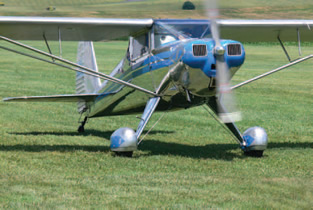
313
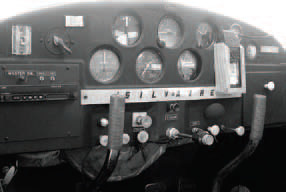
Photos by Terry Shepherd
286
Luscombe
Often mistaken for a Cessna 120/140 (which are too heavy for LSA status),
the Luscombe 8 series offered a modern metal fuselage with cloth-covered wings. Some of these have been recovered with metal. The 8A through 8D are LSA legal, but most have been converted back to 8As with engine changes.
A potential trap with these changes would be a Luscombe 8A with a Continental C-90, metal wings and wing tanks. Steve Krog (who also trains on Luscombes) says this is legal but certainly hurts useful load. Terry Bowden, who does DAR work for several legacy LSA models, tells us this switch technically make it an 8F, which has a 1400-pound gross weight—too high for LSA. Bowden is working with the FAA to clarify this and ensure these planes can keep their original gross weight of 1200 or a reduced weight of 1320.
Cruise speeds of 95-100 MPH make the Luscombe the hot-rod of this group. Short field performance is still good considering that cruise. Visibility over the nose is fine on the ground and terrific in flight. The view out the sides is less so, with smallish windows, and it’s non-existent to the rear. In fact, what you’ll see if you look behind you is the 14-gallon fuel tank with a gauge built into it that’d be easiest to read with a mirror.
Seating is side-by-side with a control stick, so entrance and egress require the same flexibility it takes to read the gas gauge. Controls are responsive, especially the rudder, which is probably where the Luscombe’s semi-undeserved reputation for being difficult to land comes from. The gear is a bit narrower than others, which may be the rest of the picture. The landing gear on the earlier models is a single oleo that’s a bit stiffer than the Champ. The heel brakes are hard to reach and only on the pilot side. Passenger-side brakes can be added.
A Luscombe will stall and spin when prompted, but it recovers well. Those familiar with the breed tell us it’s a terrific and fun flier. However, if they aren’t rigged straight due to a ground loop in the past, then they can get quirky.
Luscombe prices haven’t moved much in the past five years, but there aren’t that many out there, so it’s hard to peg a trend with authority. Parts support is acceptable for keeping a Luscombe airworthy. The Luscombe Association (www.luscombeassoc.org) is a good resource, as is The Luscombe Endowment (luscombe.org).
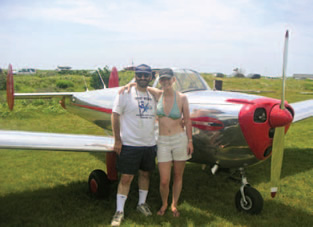
313

235
0)]
Ercoupe
The Ercoupe (or in some cases, Aircoupe) is only nosewheel airplane in this group. And that’s just the beginning of the differences. It’s also a low-wing, it’s all-metal (except for the earliest wings), it has a twin-rudder tail and if you find one with rudder pedals, it was likely a post-production conversion.
How can it have no rudder pedals but have twin rudders? The control wheel coordinates the turn for you, moving both aileron and rudder in concert. The control wheel also steers the nosegear. All legacy LSAs must be driven all the way to the tiedown, but in the Ercoupe you literally drive it. There’s a single brake pedal for stopping. There’s no right rudder for climb, but the twin rudders are outside this slipstream, so there’s less need.
For crosswinds, you land it in a crab and the trailing-link gear straighten out on their own. (Last time we discussed the ‘Coupe, we liked this straightening to a dead cow falling off a truck. We won’t make that mistake again.) The idea was to prevent ground loops, but Ercoupes can and will ground loop if set down too fast with too much crab angle.
Ercoupes also have limited elevator travel to prevent stall-spins. This means limited CG range, so they are side-by-side seats. The 24 gallons of fuel is kept in the wings with a five-gallon header tank in the cabin. Ailerons are full-span, so the roll rate is comparatively snappy. Getting one to stall is nearly impossible, by design. Cruise performance is near the top for this class, with 90-95 MPH. Climb performance is anemic on a good day, but it makes up for that by descending like a homesick anvil when the power is pulled. Ercoupes with 100-HP conversions climb better. While we’re talking conversions, a nice modification is a split elevator that adds just a bit more authority at low speeds.
Ercoupes were certified with electrical systems, which means they are the only model of these five that isn’t exempt from the ADS-B mandate in 2020. You’d only need to equip if you fly near Class B or C airspace (and you fly ADS-B free with prior permission even then), but it is a consideration for some. Even an inexpensive ADS-B Out could cost nearly a quarter the value of the aircraft.
Note that if you must be LSA-legal, only the A, B, C and CD models have low enough gross weight. They all come with electrical systems and starters. They even have lights for flying at night. The canopy opens from the center downward, so you can hang your arm out the side while you have P-38 fantasies inspired by the twin tail.
Ercoupe prices have fallen since we last looked in 2008. If you don’t mind the quirks, the airplane could be a great buy. Parts can still be had, primarily though Univair. The Ercoupe Owners’ Club is at www.ercoupe.org.
Right for You
Our top pick of this group is the Champ, hitting a sweet spot of relative roominess, flight characteristics, supportability and affordability. The best deal is probably an Ercoupe, but it’s an acquired taste.
Between the Luscombe and the Taylorcraft, we think the Taylorcraft will be easier and cheaper to support long term. The Luscombe is still a fine choice if you find a clean one. A Cub is great if you have the budget for it. It’s slower and a bit cramped, but it gets all the looks on the ramp.
With engines that burn 4-5 GPH, this is about as cheap as a gasoline airplane can get. Bring a sweater if it’s cold. Bring a noise-cancelling headset even if it isn’t plugged into anything. And if you end up parking next to a new LSA on the ramp, know that you might be slower and rough on the edges, but you’re flying one of the originals.

